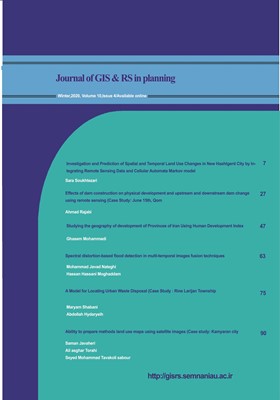آشکارسازی سیل بر پایه اعوجاج طیفی در تکنیک های ادغام تصاویر چندزمانه (مورد مطالعه: سیل دزفول)
الموضوعات :حسن حسنی مقدم 1 , محمدجواد ناطقی 2
1 - کارشناس ارشد سنجش از دور و GIS، دانشگاه خوارزمی تهران
2 - کارشناس ارشد مهندسی برق، گرایش الکترونیک، دانشکده فناوری اطلاعات و ارتباطلات، دانشگاه جامع امام حسین(ع)، تهران، ایران
الکلمات المفتاحية: آشکارسازی تغییرات, ادغام داده ها, اعوجاج طیفی, محدوده گستره سیل,
ملخص المقالة :
در فرآیند آشکارسازی تغییرات، انتخاب روش استخراج اطلاعات نقش مهمی در کیفیت آشکارسازی تغییرات نهایی دارد. در تحقیق حاضر به منظور آشکارسازی تغییرات و تعیین محدوده گستره سیل، از روش ادغام داده های چندزمانه لندست 8، بر پایه اعوجاجات طیفی استفاده شده است. برای این منظور، ابتدا هر دو تصویر قبل و بعد از سیل با استفاده از روش Gram Schmitt، ادغام گردیدند تا قدرت تفکیک مکانی تصاویر افزایش پیدا کند. در ادامه به منظور آشکارسازی تغییرات و تعیین محدوده گستره سیل از سه الگوریتم Gram Schmitt, IHS, PCA، استفاده گردید. در این تحقیق تصویر قبل از سیل به عنوان تصویر چندطیفی و تصویر باند مادون قرمز بعد از سیل به عنوان تصویر پانکروماتیک به هر یک از الگوریتم ها داده شد تا با استفاده از میزان اعوجاج طیفی به وجود آمده در هر یک از الگوریتم ها، محدوده گستره سیل مشخص شود. نتایج نشان داد که قابلیت روش ادغام داده ها بر پایه اعوجاج طیفی، در آشکارسازی تغییرات بسیار بالا می باشد. اعوجاج طیفی به وجود آمده در الگوریتم IHS، صحیح ترین اعوجاج بوده و خروجی این الگوریتم انطباق بالایی با داده مرجع دارد. همچنین خروجی الگوریتم Gram Schmitt، دارای اعوجاجات طیفی در محدوده های غیر تغییر می باشد. الگوریتم PCA، که نسبت به ورودی ها بسیار حساس است، اکثر مناطق تصویر را دارای اعواجاج کرده که استفاده از این الگوریتم در آشکارسازی تغییرات بر پایه اعوجاج طیفی پیشنهاد نمی گردد.
_||_
9] Ayele. G. T, Tebeje. A. K, Demissie. S. S, Belete. M. A, Jemberrie. M. A, Teshome. W. M., ... and Teshale, E. Z. (2018). “Time Series Land Cover Mapping and Change Detection Analysis Using Geographic Information System and Remote Sensing, Northern Ethiopia”, Air, Soil and Water Research, Vol (11).
[10] Deepthy. R and Vasuki. A.(2013). “Fusion of different images for change detection”, In ternational journal of computer application, pp. 28-37.
[11] EL Hattab. M. M.(2016). “Applying post classification change detection technique to monitor an Egyptian coastal zone”, The Egyptian journal of remote sensing and space science, Vol(19), pp. 23-36.
[12] Ferraris. V, Dobigeon. N, Wei. Q and Chabert. M.(2016). “Detecting changes between optical images of different spatial and spectral resolutions: a fusion baised approach”, Arxiv, pp. 1- 23.
[13] Francois Mas. J, Rodriguez. R. L, Lopez. R. G, Sanchez. J. L, Garduno. R. P and Flores. E. H.(2017). “land use land cover change detection combining automatic processing and visual interpretation”, European journal of remote sensing , Vol(50), pp. 626-635.
[14] Feng. W, Sui. H, Tu. J, Huang. W, Xu. Ch and Sun. K.(2018). “A novel change detection approach for multi temporal high resolution remote sensing images based on rotation forest and coarse to fine uncertainty analysis”, Remote sensing, Vol(10), pp. 1-22.
[15] Han. Y, Chang. A, Choi. S, Park. H and Choi. J.(2017). “An unsupervised algorithm for change detection in hyperspectral remote sensing data using synthetically fused image and derivative spectral profile”, Sensors, Vol(2017), pp. 1-14.
[16] Kafi. K. M, Shafri. H. Z. M, and Shariff, A. B. M. (2014). “An analysis of LULC change detection using remotely sensed data; A Case study of Bauchi City”, In IOP conference series: Earth and environmental science, Vol(20).
[17] Li. X, Zhao. Sh and Yang. H.(2017). “A bi-band binary mask based land use change detection using Landsat 8 OLI imagery”, Sustainability, Vol, (9), 47
18] Lv. Zh, Liu. T, Zhang. P, Benediktsson. J. A and Chen. Y.(2018). “Land cover change detection based on adaptive contextual information using bi-temporal remote sensing image”, Remote sensing, Vol(10), pp. 1-14.
[19] Lv. Z, Shi. W, Zhou. X and Benediktsson. J. A. (2017). “Semi-automatic system for land cover change detection using bi-temporal remote sensing images”. Remote Sensing, Vol (9), 1112.
[20] Makuti. S, Nex. F and Yang. M. Y.(2018). “multi temporal classification and change detection using UAV images”, ISPRS TC II Mid-term Symposium “Towards Photogrammetry 2020”, 4–7 June 2018, Riva del Garda, Italy (pp. 651-658). International Society for Photogrammetry and Remote Sensing (ISPRS).
[21] Onur. I, Maktav. D, Sari. M and Kemal Sönmez. N. (2009). “Change detection of land cover and land use using remote sensing and GIS: a case study in Kemer, Turkey”, International Journal of Remote Sensing, Vol (30), pp. 1749-1757.
[22] Pohl. C and Van Genderen. J. (2016). “Remote sensing image fusion: A practical guide”, Crc Press.
[23] Ramachandra. T. V and Kumar. U.(2004). “Geographic resources decision support system for land use land cover dynamics analysis”, FOSS/GRASS Users Conference - Bangkok, Thailand, 12-14 September. ISPRS, Vol(2), pp. 651-
658.
[24] Wang. G, Wang. H, Fan. W. F, Liu. Y and Chen. Ch.(2018). “Change detection of high resolution remote sensing images based on adaptive fusion of multiple feature”, ISPRS, Vol(3), pp. 1689-1694.
[25] Wang. B, Choi. J, Choi. S, Lee. S, Wu. P and Gao. Y.(2017). “Image fusion based land cover change detection using multi temporal high resolution images”, Remote sensing, Vol(9), pp. 1-19.
[26] Xiaodong. Zh, Jian Ya.


